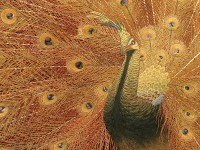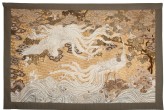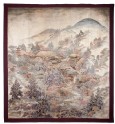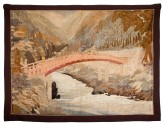Threads of Silk and Gold: Ornamental Textiles from Meiji Japan
(from 9th Nov 2012 until 27th Jan 2013)Discover exquisite embroideries, dyed silk and velvet panels, tapestries, and appliqué works

- This is a visual browsing tool that maps objects in this publication, gallery or collection trail by date of creation onto a timeline.
- The circular markers indicate where objects are on the timeline.
- The size of the markers indicates the relative number of objects at that point on the timeline.
- Hover over a marker to find out which objects are represented at that point in time.
- To expand, collapse or hide the timeline, click these symbols
 found at the top right of the timeline.
found at the top right of the timeline.
- 1850
- 1860
- 1870
- 1880
- 1890
- 1900
- 1910
- 1920
Textiles depicting Japanese mythical creatures and historical subjects were extremely popular with foreign customers. Western visitors to Japan often bought these traditional-looking textiles as ‘temple hangings’, under the impression that they were very old. This was not always the case!
Textile depictions of famous tourist spots were also popular souvenirs. Japan became increasingly accessible to foreign travellers in the late 1800s as travel restrictions were relaxed, shipping and railway lines were developed, and hotels and travel agents established. Images of Japan’s famous beauty spots and historical sites were a continuation of a long Japanese tradition of meisho-e, ‘pictures of famous places’.
 Two shishi, or lion dogs, and their young beneath a waterfall (LI1956.23)
Two shishi, or lion dogs, and their young beneath a waterfall (LI1956.23)
 Two dragons, each with a pearl of wisdom (LI1956.33)
Two dragons, each with a pearl of wisdom (LI1956.33)
 Winged dragon attacking another dragon amid stylized swirling clouds (LI1956.22)
Winged dragon attacking another dragon amid stylized swirling clouds (LI1956.22)
Notice
Objects from past exhibitions may have now returned to our stores or a lender. Click into an individual object record to confirm whether or not an object is currently on display. Our object location data is usually updated on a monthly basis, so please contact the Jameel Study Centre if you are planning to visit the museum to see a particular Eastern Art object.
© 2013 University of Oxford - Ashmolean Museum





